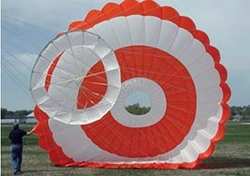Tue, Jul 29, 2003
One of the most exciting
developments in aviation is FAA's coming Sport Pilot/Light Sport
Aircraft rule. This innovative rulemaking will permit two-place
aircraft weighing up to 1,232 pounds (or possibly somewhat more
when the rule is finalized) to fly cross country at 132 mph using a
pilot's license that can be obtained with just 20 hours of
instruction and requires no medical examination. Many pilots are
anticipating this rule which EAA has been instrumental in driving
forward.
During the summer of 2003, BRS successfully completed a series
of ultimate load drop tests that prove the company's new parachute
system is up to the job… and then some. Made with the higher
speed European market in mind-where BRS sells many systems-the
BRS-1350 has the capacity to save an aircraft with a gross weight
of 1,350 pounds (615 kg). The Kevlar-reinforced canopy can also
cope with speeds up to 185 mph (300 km/h).
"We wanted to be able to serve the U.S. market and the European
market simultaneously," said BRS president and CEO, Mark Thomas.
"We are aware European airframe makers are watching Light Sport
Aircraft closely and hope to model coming regulations on the U.S.
initiative." The new BRS-1350 can accommodate all the weight and
speed anticipated from FAA's new rule yet can meet the needs of
faster aircraft in Europe.
 As the worldwide leader in
whole-aircraft parachute systems intended to rescue aircraft in
trouble along with their pilots and occupants, BRS has played a
close role in development of the Light Sport Aircraft rule. Two BRS
employees, Dan Johnson and Gregg Ellsworth, are on the
standards-writing committee charged with creating rules of
certification for parachutes for these airplanes. Since many of
these aircraft will evolve from ultralights and light kit-builts
where parachutes are widely accepted (50% of all such aircraft are
thought to be so equipped in the U.S.), it is logical that many
Light Sport Aircraft owners will want parachutes as well.
As the worldwide leader in
whole-aircraft parachute systems intended to rescue aircraft in
trouble along with their pilots and occupants, BRS has played a
close role in development of the Light Sport Aircraft rule. Two BRS
employees, Dan Johnson and Gregg Ellsworth, are on the
standards-writing committee charged with creating rules of
certification for parachutes for these airplanes. Since many of
these aircraft will evolve from ultralights and light kit-builts
where parachutes are widely accepted (50% of all such aircraft are
thought to be so equipped in the U.S.), it is logical that many
Light Sport Aircraft owners will want parachutes as well.
Since the early 1980s BRS has delivered over 18,000 parachute
systems to aircraft owners around the world including FAA-certified
production models like the Cessna 150, Cessna 172, Cirrus SR20 and
Cirrus SR22, and hundreds of non-certified recreational aircraft.
Actual documented uses of these systems are credited with saving
the lives of 157 persons through the end of July 2003. BRS is a
publicly-traded company based in South St. Paul, Minnesota.
More News
Aero Linx: Transport Canada We are a federal institution, leading the Transport Canada portfolio and working with our partners. Transport Canada is responsible for transportation p>[...]
Gross Navigation Error (GNE) A lateral deviation from a cleared track, normally in excess of 25 Nautical Miles (NM). More stringent standards (for example, 10NM in some parts of th>[...]
From AirVenture 2017 (YouTube Edition): Flight-Proven Booster On Display At AirVenture… EAA AirVenture Oshkosh is known primarily as a celebration of experimental and amateu>[...]
Aircraft Parachute System (CAPS) Was Deployed About 293 Ft Above Ground Level, Which Was Too Low To Allow For Full Deployment Of The Parachute System Analysis: The day before the a>[...]
Also: 48th Annual Air Race Classic, Hot Air Balloon Fire, FAA v Banning 100LL, Complete Remote Pilot The news Piper PA-18 Super Cub owners have been waiting for has finally arrived>[...]
 ANN's Daily Aero-Linx (06.29.25)
ANN's Daily Aero-Linx (06.29.25) ANN's Daily Aero-Term (06.29.25): Gross Navigation Error (GNE)
ANN's Daily Aero-Term (06.29.25): Gross Navigation Error (GNE) Classic Aero-TV: Anticipating Futurespace - Blue Origin Visits Airventure 2017
Classic Aero-TV: Anticipating Futurespace - Blue Origin Visits Airventure 2017 NTSB Final Report: Cirrus SR22
NTSB Final Report: Cirrus SR22 Airborne Affordable Flyers 06.26.25: PA18 Upgrades, Delta Force, Rhinebeck
Airborne Affordable Flyers 06.26.25: PA18 Upgrades, Delta Force, Rhinebeck



